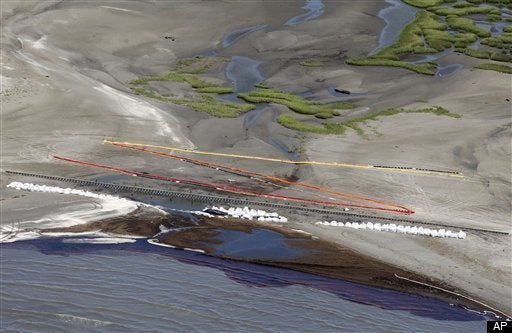
Acting on the urgent need to address the Gulf Oil Spill over the last few weeks, BP has dumped millions of gallons of a dispersant product, called Corexit, into the Gulf. Environmental groups have questioned the product's safety.
While guarding its proprietary ingredients, NALCO which produces Corexit, claims on its website that the dispersant is "safer than dish soap."
Without actually naming Corexit's ingredients, the company says they're just like those in "detergents and other household cleaning products." Its main ingredients are so safe, says the company, that they are used in fruit drinks, skin cream, body shampoo, baby bath liquid, cosmetics, household cleaning products, hand creams and stain blockers.
Should we feel reassured to learn that the same ingredients are found in both an environmental dispersant and products in daily use?
That's hard to ascertain when both household and industrial products contain many chemical ingredients that have never been studied for safety singly, or as used in combination formulas. Nor have they been studied for the exposure levels people experience. Most of them -- the over 80,000 industrial and household chemicals in wide use-- haven't been studied period.
Nor are companies required to reveal their ingredients, since many formulas, like both Corexit and hey, even laundry dryer sheets, are protected as "trade secrets."
That means that the potential impacts of their use remain not only unknown -- but unknowable, leading to confusion during emergencies.
Strict guidelines for using dispersants make it "unlikely that the general public will be exposed (directly) to (the) product," says a May 2010 report by the Centers for Disease Control.
But Wilma Subra, a Louisiana based chemist, counters that people are being exposed. Local fisherman helping with the cleanup efforts experienced symptoms so severe, "they went to the hospital. But the medical staff couldn't do much because they didn't know what (they'd) been exposed to. Most of the chemicals were proprietary."
"When I try to get the scientific information I need to advise (people reporting health symptoms), I hit a wall, " said Dr. Gina Solomon, MD, MPH, a Senior Scientist with the Natural Resources Defense Council, who has also been on the scene in the Gulf area.
When private trade secrets translate into public health problems, the shortfalls of the laws governing chemical safety aren't confined to the Gulf crisis. After fracking, a widely used gas drilling process, came to Dish, Texas, a foul odor pervaded the town. Soon people fell ill, and all trees adjacent to the production site were "dead or dying," said Mayor Calvin Tillman, as reported in Open Salon. But doctors lacked necessary information because the 500 chemicals used in fracking were both proprietary and exempted from the Clean Water Act, by former Vice-President Cheney.
With no way to compel industry to admit or redress the impacts of its practices, the town was forced to commission its own study, which identified multiple carcinogens in the town air. These correlated with 61 percent of the health effects town residents reported, including "difficulty in breathing, brain disorders, chronic eye irritation, dizziness, frequent nausea, increased fatigue, muscle aches, severe headaches, sinus problems, throat irritation and allergies," Open Salon reported. But without prior safety studies, content disclosure or company accountability, the tiny Texas town had to obtain the information itself. Similar unknowns may loom in the Gulf, because of the "don't ask, don't tell" policy on synthetic chemicals, leaving us unprepared for emergencies.
Should a product's safety (or lack thereof) be determined only after its use appears to have caused harm? Should the burden of proof be imposed upon each individual or each community that experiences negative impacts?
The coalition Safer Chemicals, Healthy Families says no. It supports the new Safe Chemicals Act, to be voted on by Congress in the coming months. Introduced to revise the outdated Toxic Chemicals Safety Act, it aims to place the burden of proof on companies who are not currently required to test dispersants, nor to promptly reveal so-called proprietary ingredients in rapid response to spills, or for health responders and researchers. The new law would require data that demonstrates a dispersant's short and long-term effects on all varieties of wildlife, and on human health.
Recently, the EPA disclosed a complete list of ingredients found in Corexit, but questions remain. One formulation, which NALCO claims was used initially from existing stores, contains 2-butoxy ethanol, a carcinogen that can be inhaled and absorbed through the skin and eyes. According to a product safety data sheet, the formulation in current use is safer. It's classified as an "immediate acute health hazard," while "no toxicity studies have been done on this product."
For now, we can only guess the long term effects of Corexit. But why should we have to guess?
For health insight and action, get Your Health Outlook, a free ezine at www.healthjournalist.com